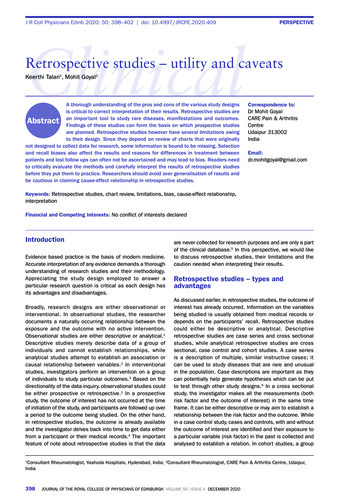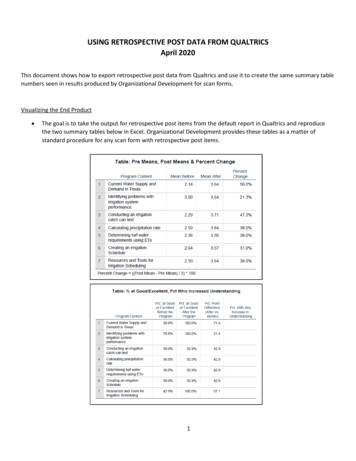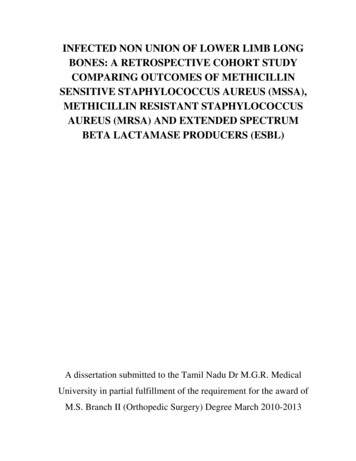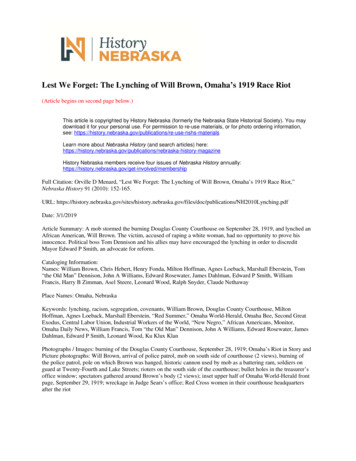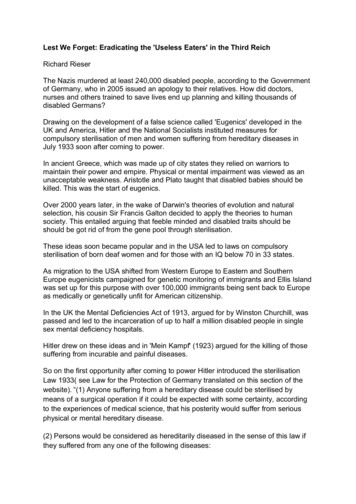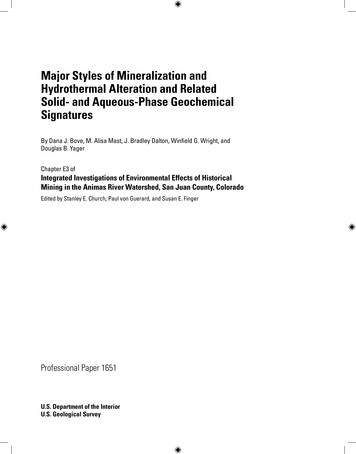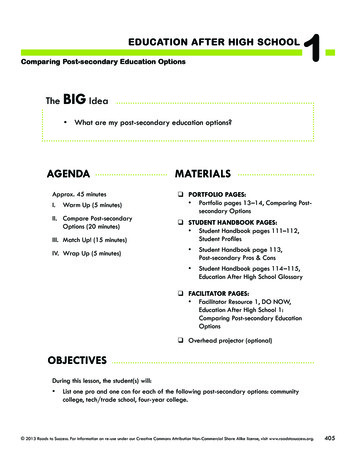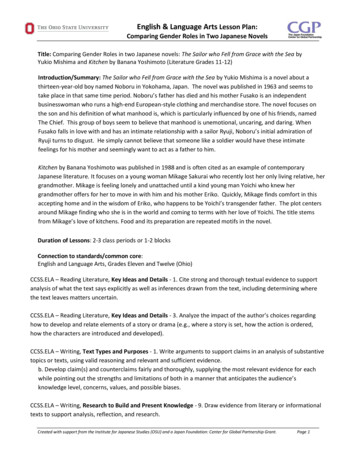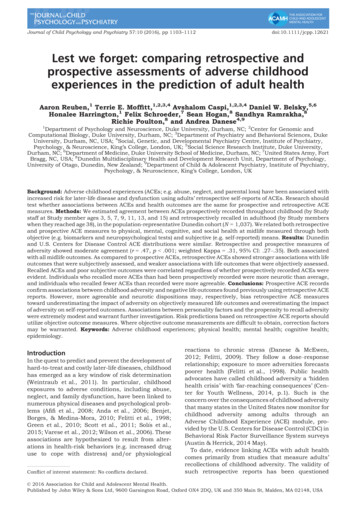
Transcription
Journal of Child Psychology and Psychiatry 57:10 (2016), pp 1103–1112doi:10.1111/jcpp.12621Lest we forget: comparing retrospective andprospective assessments of adverse childhoodexperiences in the prediction of adult healthAaron Reuben,1 Terrie E. Moffitt,1,2,3,4 Avshalom Caspi,1,2,3,4 Daniel W. Belsky,5,6Honalee Harrington,1 Felix Schroeder,7 Sean Hogan,8 Sandhya Ramrakha,8Richie Poulton,8 and Andrea Danese4,91Department of Psychology and Neuroscience, Duke University, Durham, NC; 2Center for Genomic andComputational Biology, Duke University, Durham, NC; 3Department of Psychiatry and Behavioral Sciences, DukeUniversity, Durham, NC, USA; 4Social, Genetic, and Developmental Psychiatry Centre, Institute of Psychiatry,Psychology, & Neuroscience, King’s College, London, UK; 5Social Science Research Institute, Duke University,Durham, NC; 6Department of Medicine, Duke University School of Medicine, Durham, NC; 7United States Army, FortBragg, NC, USA; 8Dunedin Multidisciplinary Health and Development Research Unit, Department of Psychology,University of Otago, Dunedin, New Zealand; 9Department of Child & Adolescent Psychiatry, Institute of Psychiatry,Psychology, & Neuroscience, King’s College, London, UKBackground: Adverse childhood experiences (ACEs; e.g. abuse, neglect, and parental loss) have been associated withincreased risk for later-life disease and dysfunction using adults’ retrospective self-reports of ACEs. Research shouldtest whether associations between ACEs and health outcomes are the same for prospective and retrospective ACEmeasures. Methods: We estimated agreement between ACEs prospectively recorded throughout childhood (by Studystaff at Study member ages 3, 5, 7, 9, 11, 13, and 15) and retrospectively recalled in adulthood (by Study memberswhen they reached age 38), in the population-representative Dunedin cohort (N 1,037). We related both retrospectiveand prospective ACE measures to physical, mental, cognitive, and social health at midlife measured through bothobjective (e.g. biomarkers and neuropsychological tests) and subjective (e.g. self-reported) means. Results: Dunedinand U.S. Centers for Disease Control ACE distributions were similar. Retrospective and prospective measures ofadversity showed moderate agreement (r .47, p .001; weighted Kappa .31, 95% CI: .27–.35). Both associatedwith all midlife outcomes. As compared to prospective ACEs, retrospective ACEs showed stronger associations with lifeoutcomes that were subjectively assessed, and weaker associations with life outcomes that were objectively assessed.Recalled ACEs and poor subjective outcomes were correlated regardless of whether prospectively recorded ACEs wereevident. Individuals who recalled more ACEs than had been prospectively recorded were more neurotic than average,and individuals who recalled fewer ACEs than recorded were more agreeable. Conclusions: Prospective ACE recordsconfirm associations between childhood adversity and negative life outcomes found previously using retrospective ACEreports. However, more agreeable and neurotic dispositions may, respectively, bias retrospective ACE measurestoward underestimating the impact of adversity on objectively measured life outcomes and overestimating the impactof adversity on self-reported outcomes. Associations between personality factors and the propensity to recall adversitywere extremely modest and warrant further investigation. Risk predictions based on retrospective ACE reports shouldutilize objective outcome measures. Where objective outcome measurements are difficult to obtain, correction factorsmay be warranted. Keywords: Adverse childhood experiences; physical health; mental health; cognitive health;epidemiology.IntroductionIn the quest to predict and prevent the development ofhard-to-treat and costly later-life diseases, childhoodhas emerged as a key window of risk determination(Weintraub et al., 2011). In particular, childhoodexposures to adverse conditions, including abuse,neglect, and family dysfunction, have been linked tonumerous physical diseases and psychological problems (Afifi et al., 2008; Anda et al., 2006; Benjet,Borges, & Medina-Mora, 2010; Felitti et al., 1998;Green et al., 2010; Scott et al., 2011; Sol ıs et al.,2015; Varese et al., 2012; Wilson et al., 2006). Theseassociations are hypothesized to result from alterations in health-risk behaviors (e.g. increased druguse to cope with distress) and/or physiologicalConflict of interest statement: No conflicts declared.reactions to chronic stress (Danese & McEwen,2012; Felitti, 2009). They follow a dose–responserelationship; exposure to more adversities forecastspoorer health (Felitti et al., 1998). Public healthadvocates have called childhood adversity a ‘hiddenhealth crisis’ with ‘far-reaching consequences’ (Center for Youth Wellness, 2014, p.1). Such is theconcern over the consequences of childhood adversitythat many states in the United States now monitor forchildhood adversity among adults through anAdverse Childhood Experience (ACE) module, provided by the U.S. Centers for Disease Control (CDC) inBehavioral Risk Factor Surveillance System surveys(Austin & Herrick, 2014 May).To date, evidence linking ACEs with adult healthcomes primarily from studies that measure adults’recollections of childhood adversity. The validity ofsuch retrospective reports has been questioned 2016 Association for Child and Adolescent Mental Health.Published by John Wiley & Sons Ltd, 9600 Garsington Road, Oxford OX4 2DQ, UK and 350 Main St, Malden, MA 02148, USA
1104Aaron Reuben et al.because of possible misclassification and bias. Onone hand, adult participants may not be able toretrieve episodic memory from their early years (socalled infantile amnesia; Pillemer & White, 1989;Usher & Neisser, 1993) and may fail to correctlyretrieve episodic memory from their distant past,particularly at older ages (H anninen & Soininen,2012). On the other hand, adult participants may bemore or less likely to report childhood adversitybased on individual features. For example, they maychoose not to divulge intimate information to avoiddistress or embarrassment (Hardt & Rutter, 2004).Alternatively, the presence of disease, psychopathology, or certain personality styles may unconsciouslyincrease an individual’s propensity to recall childhood adversity – artificially linking childhood experience and adult disease outcomes (Colman et al.,2016; Henry, Moffitt, Caspi, Langley, & Silva, 1994;Matt, Vazquez, & Campbell, 1992; McFarland &Buehler, 1998; Prescott et al., 2000; Susser &Widom, 2012). Although prospective measures ofchildhood adversity are less sensitive to bias linkedto individual features, their validity may nevertheless be limited because of other sources of misclassification including underreporting by caregivers orunderdetection by agencies (Hardt & Rutter, 2004).The goal of our study was to compare retrospectiveand prospective measures of ACEs in the predictionof later-life disease and dysfunction. Poor adulthealth and social outcomes have been associatedwith prospectively measured ACEs (Sol ıs et al.,2015). However, to our knowledge, only one previouscomparison of outcome predictions from retrospective and prospective measures of ACEs in the samesample has been undertaken (Patten et al., 2015).Past comparisons of retrospective and prospectivereports of child maltreatment raised concern thatthese two forms of measurement do not match and,further, do not predict outcomes equally (e.g. Horwitz, Widom, McLaughlin, & White, 2001; Widom &Engel, 1996; Widom & Morris, 1997), although atleast one study has reported low agreement betweenmeasures but similar prediction of mental-healthoutcomes (Scott, McLaughlin, Smith, & Ellis, 2012).Furthermore, evidence suggests that retrospectivereports of ACEs are inconsistent over time, depending on psychological distress at the time of recall(Colman et al., 2016). Here, we compare the associations among retrospective and prospective measures of ACEs and physical, cognitive, mental, andsocial health outcomes. Based on previous literature(e.g. Hardt & Rutter, 2004), we predicted that ourprospective and retrospective ACE measures wouldshow moderate agreement and that both wouldassociate with later-life outcomes. We conductedour comparison in the Dunedin Study, a populationrepresentative longitudinal birth-cohort born in theearly 1970s and followed to early midlife. ProspectiveACE counts were generated from dossiers that wecompiled for each Study member, which containedJ Child Psychol Psychiatr 2016; 57(10): 1103–12information drawn from Study staff assessmentsand observations, parent and teacher reports, andevidence of social service contacts collected at Studymember ages 3, 5, 7, 9, 11, 13, and 15. RetrospectiveACE counts were generated from Study memberrecollections of childhood adversity reported inadulthood.In addition to potential discrepancies betweenretrospectively recalled and prospectively recordedACEs, we anticipated differences in associations ofACE measures with outcomes that are objectivelymeasured as compared with those that aremeasured subjectively (i.e. through self-report).Health-psychology research has documented thatself-reports tend to be suffused with biases stemming from reporters’ personality styles, like neuroticism, while objective measures are not (Watson &Pennebaker, 1989). We, therefore, tested both objective and subjective outcome measurements.Finally, because personality styles may also influence recall of ACEs, we tested if reporters’ personalitystyles were associated with discrepant retrospectivelyrecalled and prospectively recorded ACE exposures.MethodsSampleParticipants are members of the Dunedin Study, a longitudinalinvestigation of health and behavior in a representative birthcohort. Study members (N 1,037; 91% of eligible births; 52%male) were all of the individuals born between April 1972 andMarch 1973 in Dunedin, New Zealand (NZ), who were eligiblebased on residence in the province and who participated in thefirst assessment at age 3. The cohort represented the full range ofsocioeconomic status (SES) in the general population of NewZealand’s South Island. On adult health, the cohort matches theNew Zealand National Health and Nutrition Survey on key healthindicators (e.g. body mass index, smoking, visits to the doctor;Poulton, Moffitt, & Silva, 2015). The cohort is primarily white;fewer than 7% self-identify as having non-Caucasian ancestry,matching the demographics of the South Island (Poulton et al.,2015). Assessments were carried out at birth and ages 3, 5, 7, 9,11, 13, 15, 18, 21, 26, 32, and, most recently, 38 years, when95% of the 1,007 study members still alive took part. In theinterest of reproducibility, the analysis plan for this article wasposted in advance (http://www.moffittcaspi.com; Trinh & Sun,2013). Study member informed consent was obtained, withstudy protocol approval by the institutional ethical reviewboards of the participating universities.MeasuresAdverse childhood experiences (ACEs). The U.S.Centers for Disease Control & Prevention (CDC) has articulateda leading approach to conceptualizing ACEs (Felitti et al.,1998). Our measure of ACEs corresponds to the 10 categoriesof childhood adversity introduced by the CDC Adverse Childhood Experiences Study (Felitti et al., 1998; valence.html): Five typesof child harm (physical abuse, emotional abuse, physicalneglect, emotional neglect, and sexual abuse) and five typesof household dysfunction (incarceration of a family member,household substance abuse, household mental illness, loss ofa parent, and household partner violence). Because the 2016 Association for Child and Adolescent Mental Health.
1105Measurement method affects ACE prediction of adult health 2016 Association for Child and Adolescent Mental Health.(A)50%CDC ACEs study40%Dunedin prospective ACEsDunedin retrospective ACEs30%20%10%0%01234 Total ACE counts(B)40%Dunedin prospective30%Dunedin ontspalnofLosstaenmdbssureeseusl labusese0%EmDunedin Study began in the early 1970s and the awareness ofACEs in the health sciences dates to the mid-1990s, DunedinStudy operational definitions of retrospective and prospectiveACEs were necessarily somewhat different.Retrospective ACE counts: The ACE Study collects retrospectively recalled ACEs via a self-report n/acestudy/prevalence.html). Our retrospective ACEs measure draws on structuredinterviews conducted when Dunedin Study participants wereadults. Like the CDC ACE Study, we administered the Childhood Trauma Questionnaire (CTQ) (Bernstein & Fink, 1998),which ascertains physical, sexual, and emotional abuse,physical neglect, and emotional neglect; the CTQ was administered at age 38. Following the CTQ manual, a specificcategory of harm was present if the Study member had amoderate to severe score. Study members were also interviewed about memories of exposure to family substance abuse,mental illness, and incarceration during childhood via theFamily History Screen (Milne et al., 2009). Exposure to partnerviolence was assessed by asking Study participants, ‘Did youever see or hear about your mother/father being hit or hurt byyour father/mother/stepfather/stepmother?’ We also interviewed participants about parental loss (due to separation,divorce, death, or removal from home).Prospective ACE counts: Prospective ACE counts were generated from archival Dunedin Study records gathered duringseven biennial assessments carried out from ages 3 to15 years. The records include the following: social servicecontacts; structured notes from assessment staff who interviewed Study children and their parents; structured notes frompediatricians and psychometricians who observed mother–child interactions at the research unit; structured notes fromnurses who recorded conditions witnessed at home visits; andnotes of concern from teachers who were surveyed about theStudy children’s behavior and performance. Separately, parental criminality was surveyed via postal questionnaire to theparents. Attrition analysis found no significant difference inexposure to ACEs between those individuals who completedthe Study assessment at age 38 and those who did not (X2 (4,N 1,034) 7.36, p .12). Prospective ACEs data were missing for only 3 of the 1,037 cohort members.Archival Study data were reviewed in 2015 by four independent raters who were trained on the CDC definitions of ACEs.Individual ACEs were agreed upon by at least three of the fourraters 80% of the time. The sole exception was emotionalneglect where half the cases were identified by only two raters.Agreement across the full ACE count between the four ratersranged from kappa .76 to .82, with an average inter-rateragreement kappa of .79.The completeness of archival Dunedin Study records ofadversity varied by the type of ACE considered. Some ACEs(notably childhood sexual abuse) will have been underdetectedto the extent that these experiences were not actively queried,reflecting assumptions in the 1970s that sexual abuse wasexceedingly rare (Jenny, 2008). To ensure that potentialunderdetection in any ACE category did not bias the resultsof our analyses, we repeated the full suite of tests used in thisstudy with each type of ACE iteratively removed from the totalACE count. As presented in Results section, these ‘leave-oneout’ analyses produced no significant changes to the results.Prevalence of retrospective and prospective ACEs in theDunedin cohort: Each ACE type was coded as present ( 1) ornot, with a theoretical maximum of 10 ACEs. (Following theCDC ACE Study, scores were coded 0, 1, 2, 3, or 4 for allanalyses.) Figure 1A shows a similar, zero-inflated, distribution of ACEs in the Dunedin Study whether ACEs weregathered retrospectively or prospectively. The figure alsodocuments that the Dunedin ACE distribution resembled thatof the CDC ACE Study. According to retrospective reports, ourcohort experienced more ACEs than they did according to ourprospective records. Figure 1B shows that prospective ratesPhdoi:10.1111/jcpp.12621Figure 1 (A) Distribution of ACEs in the Dunedin cohort,recorded prospectively and retrospectively, with comparison toACE distributions reported in the CDC ACE Study. Distribution ofACEs in the CDC ACE Study from table 1 of Felitti et al. (1998, p.248). (B) Prevalence of individual ACEs in the Dunedin cohort, asrecorded by prospective and retrospective measurementwere lower than retrospective rates on many, though not all,types of adversity.Adult health and social outcomes. We assessed fouroutcome domains: physical, cognitive, mental, and socialhealth. In every domain, where possible, each outcome wasmeasured both objectively and subjectively. Table 1 describesthe outcome measures, which have been previously publishedin the Dunedin Study.Potentially biasing Big Five personality factors. TheBig Five were assessed at age 38 via informants (Israel et al.,2014). Study members nominated someone who knew them well;most were best friends, partners, or other family members, with a97% response rate. These ‘informants’ were mailed questionnaires asking them to describe the Study member using a briefversion of the Big Five Inventory (Benet-Mart ınez & John, 1998),which assesses individual differences in: Extraversion (a .79),Agreeableness (a .75), Neuroticism (a .83), Conscientiousness (a .81), and Openness to Experience (a .85).ResultsDo retrospective and prospective ACE measuresagree?Table 2 presents the correlation and agreement(Cohen’s Kappa) coefficients between ACE scores
1106Aaron Reuben et al.J Child Psychol Psychiatr 2016; 57(10): 1103–12Table 1 Health and social outcomesDomainsPhysical healthCognitive healthMental healthSocial healthSubjectiveObjectiveSelf-rated poor healthSelf-rated poor health was measured at age 38 by a5-point scale in response to the question: ‘Ingeneral, would you say your health is?’ Responseoptions were ‘poor’, ‘fair’, ‘good’, ‘very good’, or‘excellent’. (Idler & Benyamini, 1997)Biomarker-indexed poor healthBiomarker-indexed poor health is an objectivemeasure of physical health taken by summing nineindicators of physical health measured at age 38including metabolic abnormalities (waistcircumference, high-density lipoprotein level,triglyceride level, blood pressure, and glycatedhemoglobin), cardiorespiratory fitness, pulmonaryfunction, periodontal disease, and systemicinflammation. Details are provided in Israel et al.(2014)Working memory performance on the WAIS-IVWorking memory performance was assessed at age38 through the Working Memory Index of theWechsler Adult Intelligence Scale–IV (WAIS-IV)(Wechsler, 2008)Complaints of cognitive impairmentStudy members reported at age 38 how often in thepast year (never, sometimes, or often) theyexperienced problems with, e.g. keeping track ofappointments, remembering why they went to astore, repeating the same story to someone, multitasking, thinking when the TV or radio is on, wordfinding difficulty, among other items based onsymptom criteria for DSM-IV Mild NeurocognitiveDisorder. Scores on the 19 questions were summed(score range 0–31; mean (SD) 9.1 (5.3); internalconsistency reliability 0.83). The complaintsscore was converted to a Z-score, mean 0, SD 1(Moffitt et al., 2015)p-factor of General PsychopathologyOur measure of poor mental health is a generalfactor of psychopathology, the p-factor, derivedfrom confirmatory factor analysis of symptom-levelpsychopathology data collected in the Studypopulation between ages 18 and 38. Every 2–6 years, Study members were interviewed aboutpast-year symptoms of DSM-defined disorders bytrained nonlay interviewers. Details on the p-factorare provided in Caspi et al. (2014)Poor Partner Relationship QualityPoor partner relationship quality was assessed atage 38 through a 28-item survey about sharedactivities and interests, balance of power, respectand fairness, emotional intimacy and trust, andopen communication (a .93) (Cerd a et al., 2016)measured retrospectively and prospectively. At theitem level, agreement between retrospectivelyrecalled and prospectively recorded adversities ranged from excellent (loss of parent) to poor (emotionalabuse). At the scale level of total ACE count, thecorrelation between retrospective and prospectiveACE scores was r .47, p .001, a moderate effectsize. Precise agreement between the number ofadverse experiences retrospectively recalled andprospectivelyrecordedwasfair(weightedKappa .31, 95% CI: .27–.35). Table S1 shows thepercentage of prospectively measured ACEs thatwere retrospectively recalled and the percentage ofretrospective ACEs that were prospectively recorded.Further analyses showed the overall level of agreement between retrospective and prospective reportswas dependent, in part, on the high level of agreement about parental loss. Agreement between retrospective and prospective reports was lower whenOur study includes no objective measures of mentalhealth as there are no lab tests for mental disordersOur study includes no objective measure of partnerrelationship quality as this is generally measuredonly through self or partner/informant reports.Given the late onset of marriage and high rates ofde-facto relationships, divorce is not a usefulobjective indicator of poor relationshipparental loss was not a part of the ACE measure(Table S2).Do retrospective and prospective ACE measurespredict later-life health and social outcomes?Despite only moderate agreement between retrospective and prospective ACE measures, both wereassociated with later-life outcomes (Table 3). Effectsizes for associations between prospective ACEs andadult outcomes were small and relatively uniform(from r .11 to r .23, Table 3, Column 1). Incontrast, effect sizes for associations between retrospective ACEs and outcomes were more variable(Table 3, Column 3). Retrospective ACE associationswith objectively measured outcomes had smallereffect sizes as compared with associations withsubjectively measured outcomes (e.g. r .07 forbiomarker-indexed poor physical health versus 2016 Association for Child and Adolescent Mental Health.
doi:10.1111/jcpp.12621Measurement method affects ACE prediction of adult healthTable 2 Correlation and agreement among prospective andretrospective ACE measures (N 950)CorrelationACEPearson’s 6.15.83.10.31Child harmPhysical abuseEmotional abusePhysical neglectEmotional neglectSexual abuseHousehold dysfunctionFamily member incarcerationHousehold substance abuseHousehold mental illnessLoss of parentHousehold partner violenceTotal ACE countNotes: *p .05; **p .01; ***p .001.r .18 for self-reported poor physical health). Thelargest effect sizes were for associations betweenretrospective ACEs and outcomes of a more psychological nature (mental and social health; e.g. r .40for psychopathology).Do beliefs about childhood adversity predictoutcomes regardless of what adversities wereprospectively recorded?We used multivariate linear regressions to testassociations between retrospective ACE counts andadult outcomes while controlling for prospectiveACE counts (Table 3). For subjectively measuredoutcomes, retrospective ACEs remained a statistically significant predictor even after accounting forprospective ACEs. In contrast, retrospective ACEassociations with objectively measured outcomesdropped to nonsignificance after adding controlsfor prospective ACEs (Table 3, Column 4). Thispattern of results suggested that, regardless of whatprospective childhood records indicated, individuals’beliefs that they experienced adversity appeared tobe strongly related to their appraisals of theircurrent life outcomes. The belief that one hasexperienced childhood adversity did not, however,necessarily relate to outcomes that were objectivelymeasured once prospective adversities were takeninto account.Do prospectively recorded adversities predictoutcomes regardless of beliefs about childhoodadversity?We used multivariate linear regressions to test associations between prospective ACE counts and adultoutcomes while controlling for retrospective ACEcounts (Table 3). As Column 2 in Table 3 shows,prospective ACE associations with all subjectively 2016 Association for Child and Adolescent Mental Health.1107measured outcomes dropped to nonsignificance aftercontrolling for retrospective ACE counts. In contrast,prospective ACEs remained a statistically significantpredictor of objectively measured outcomes afteradding controls for retrospective counts. This patternof results suggested two things. First, greater adversity in childhood was followed by poorer mid-lifeoutcomes (e.g. poorer physical and cognitive health)regardless of whether or not the adversity wasremembered. Second, individuals who did not recalltheir prospectively recorded adversities when interviewed as adults tended not to make negativeappraisals of their life outcomes.Were findings biased by potentially missingprospective ACEs?As noted earlier, sexual abuse may have beenunderrecorded in the prospective ACE data. Sexualabuse is thought to be especially harmful. To evaluate whether this underdetection could have biasedassociations between prospective ACEs and adultoutcomes, we repeated our analyses with sexualabuse removed from the count of total retrospectiveand prospective ACEs. If false negatives for sexualabuse biased the prospective ACE associations withoutcomes, the strength of outcome associations forthe two ACE measures should become more similarafter removing sexual abuse from total ACE counts.We then also iteratively removed each additionalACE type from our total count in turn and re-ran theanalyses. These leave-one-out tests did not changethe results, suggesting that the overall results wereunlikely to have been biased by misclassification inany of the ACEs components. Results of leave-oneout tests are reported in Figure S1.Are personality factors linked to ACE reports?Our analysis suggested that ACE associations withadult outcomes depended on what was rememberedfrom childhood in the case of some outcomes but notothers. For objectively measured adult outcomes(e.g. health measured using biomarker indices),prospectively recorded childhood adversity that wasnot recalled by participants in adulthood nevertheless predicted poor adult outcomes. In contrast,prospectively recorded adversities that were notrecalled in adulthood were unrelated to adult outcomes measured by subjective self-reports. Thissuggested that self-reports of adult outcomes couldbe biased by some individuals taking an overlypositive view of their childhood and adulthood.Further, adversity that was recalled but not prospectively recorded predicted self-reports of poor healthand memory problems that were not confirmed byobjective outcome tests. This suggested that selfreports of adult outcomes could also be colored bysome individuals taking an overly negative view oftheir childhood and adulthood.
1108Aaron Reuben et al.J Child Psychol Psychiatr 2016; 57(10): 1103–12Table 3 Associations of prospectively recorded and retrospectively reported counts of adverse childhood experiences (ACEs) withphysical, cognitive, mental, and social health outcomes by age 38. The table shows that both prospective and retrospective ACEs arerelated to poorer outcomes by midlife (white columns). Prospective ACE associations with all self-reported outcomes dropped tononsignificance after adjusting for retrospective ACE counts while the associations with the objectively measured outcomesremained (first gray column). Retrospective ACE associations with all self-reported outcomes remained after adjusting forprospective ACE counts while the associations with the objectively measured outcomes dropped to nonsignificance (second graycolumn)Prospective ACE countsUnadjustedNSelf-reported outcomesPhysical healthSelf-reported poor healthCognitive healthSelf-reported poor memoryMental healthSelf-reported psychopathology(clinical interview)Social healthSelf-reported poorrelationship qualityaObjectively measured outcomesPhysical healthBiomarker-derived poor healthCognitive healthPoor tested working memoryAdjusted forretrospective ACE countsEffect size (Pearson’s r)Retrospective ACE countsUnadjustedAdjusted for prospectiveACE countsEffect size (Pearson’s r)950.13*** (.07, .20).05 ( .02, .12).18*** (.12, .24).16*** (.09, .23)946.11** (.05, .17).06 ( .01, .13).13*** (.06, .19).10** (.03, .17)950.23*** (.16, .28).05 ( .02, .12).40*** (.34, .46).38*** (.31, .44)844.11** (.04, .18).01 ( .07, .09).21*** (.14, .27).20*** (.13, .28)920.11** (.04, .17).09* (.02, .16).08* (.02, .15).04 ( .03, .11)938.15*** (.09, .22).15*** (.08, .23).07* (.01, .13).00 ( .07, .07)Notes: *p .05; **p .01; ***p .001. All analyses were conducted controlling for sex. 95% confidence intervals for the effects arereported in parentheses. Effect sizes may be compared at onship quality was not obtained for 105 Study members who had no partner within the past year.We next tested for the potential influence ofpersonality factors on adult ACE recall and anindividual’s potential discrepancy between prospective and retrospective ACE counts. To quantify thisdiscrepancy, we subtracted each participant’sprospective ACE exposure score from their retrospective ACE score to create a measure of directional divergence ranging from 10 to 10. Resultsshowed that three personality traits were significantly linked to the discrepancy between retrospective and prospective data: Neuroticism (r .10,p .01), Conscientiousness (r .07, p .05), andAgreeablene
Lest we forget: comparing retrospective and prospective assessments of adverse childhood experiences in the prediction of adult health Aaron Reuben,1 Terrie E. Moffitt,1,2,3,4 Avshalom Caspi,1,2,3,4 Daniel W. Belsky,5,6 Honalee Harrington,1 Felix Schroeder,7 Sean Hogan,8 Sandhya Ramrakha,8 Richie Poulton,8 and Andrea Danese4,9 1Department of Psychology and Neuroscience, Duke University .
